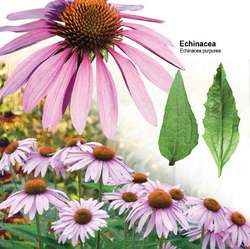Echinacea
[‚ek·ə′nā·shə] (invertebrate zoology)
A suborder of echinoderms in the order Euechinoidea; individuals have a rigid test, keeled teeth, and branchial slits.
McGraw-Hill Dictionary of Scientific & Technical Terms, 6E, Copyright © 2003 by The McGraw-Hill Companies, Inc.
echinacea
The famous immune system stimulant that’s touted as a healing wonder, used for everything from herpes to brown recluse spider bites. Great for colds, flu and anything your body may be fighting. Increases levels of virus-fighting interferon in the body. Prompts the thymus, bone marrow, and spleen to produce more immune cells. Helps cleanse the blood and boost lymph system cleansing making it a powerful detoxifier for removing infection organisms. Used on hard-to-heal wounds, even sun-damaged skin. Cortisone-like activity. Increases levels of virus-fighting interferon in the body. Not recommended for people with HIV or AIDS. The flower has a brown spiky seed ball with long thin pinkish purple petals around it. The whole plant is edible. Most of the power is in the root, but you can use the flower and seeds by crushing and drying them and making tea. Fresh flower petals make salads and desserts look beautiful. The seeds can be ground into a powder and used as a black pepper type spice. The seeds can also be sprouted and eaten as echinacea sprouts.(good winter food)
Edible Plant Guide © 2012 Markus Rothkranz
The following article is from The Great Soviet Encyclopedia (1979). It might be outdated or ideologically biased.
Echinacea
(purple coneflower), a genus of perennial herbaceous plants of the family Compositae. The stems reach 1–1.5 m in height, and the inflorescences are large heads. The ray flowers are purple, crimson, or, less commonly, whitish; the disk flowers are blackish purple. There are about five species, distributed in North America. The plants have bactericidal properties and are ornamentals. E. purpurea and E. angustifolia are cultivated. Sometimes the Echinacea are included in the genus Rudbeckia.
The Great Soviet Encyclopedia, 3rd Edition (1970-1979). © 2010 The Gale Group, Inc. All rights reserved.
